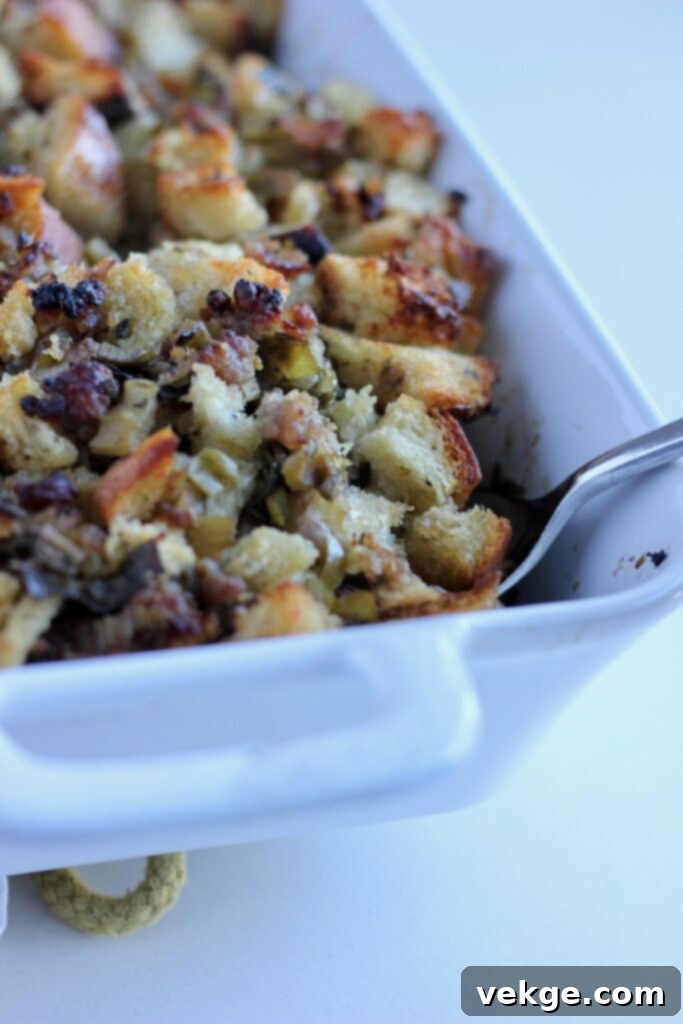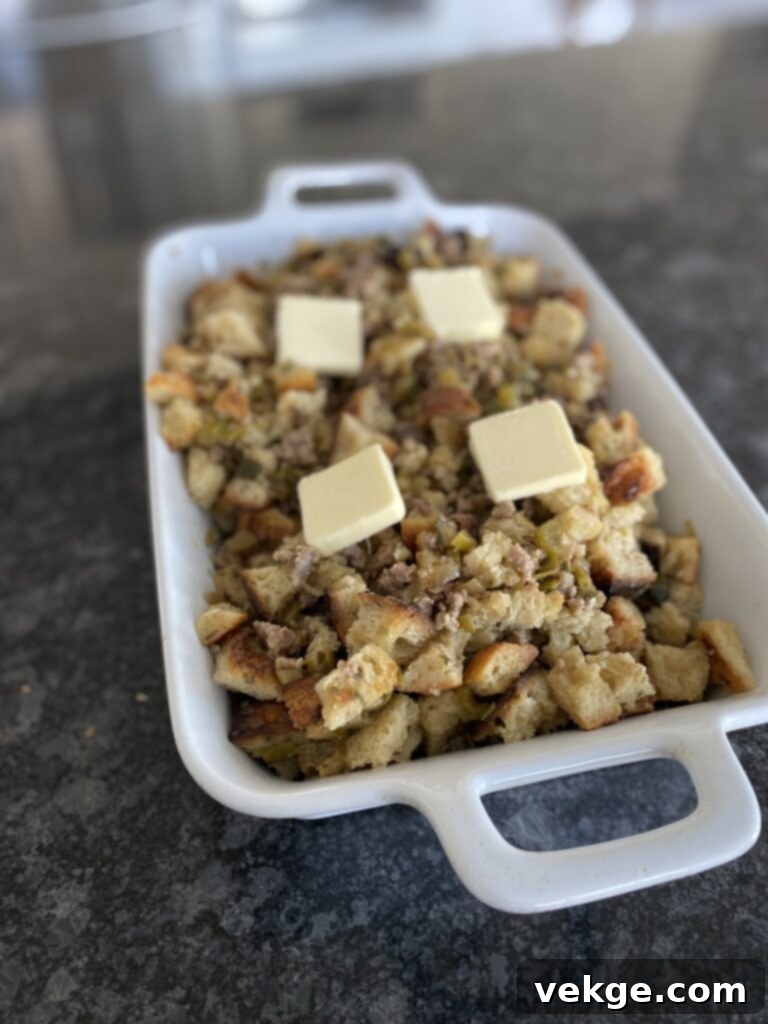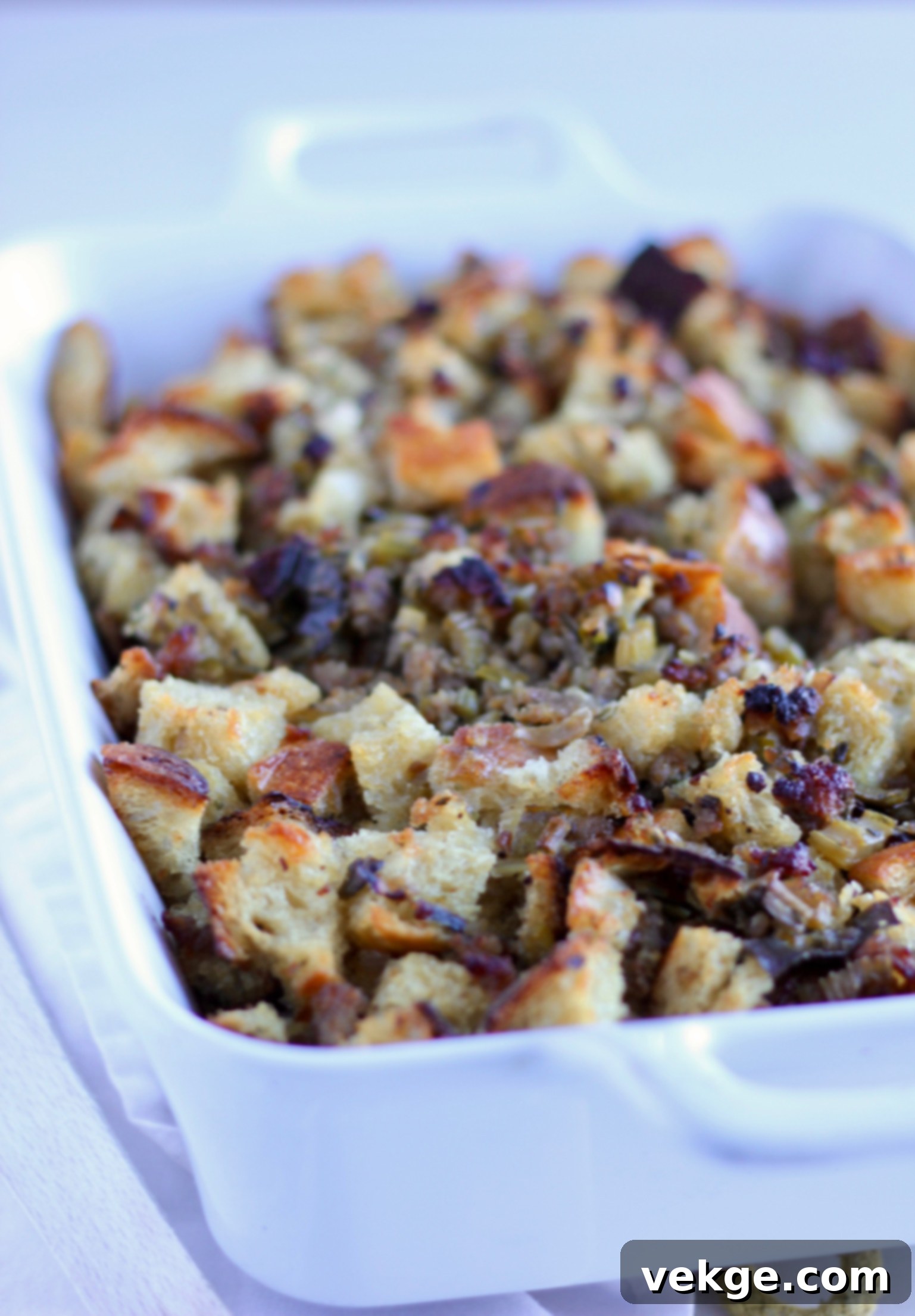
Classic Sourdough Stuffing with Sausage: The Ultimate Thanksgiving Showstopper
Prepare to elevate your holiday table with a truly unforgettable dish: homemade Sourdough Stuffing with Sausage. This isn’t just any side; it’s a culinary masterpiece that promises to steal the spotlight from the turkey itself. Brimming with savory country sausage, aromatic vegetables, and the delightful tang of sourdough bread, all baked to golden perfection with a hint of rich butter, this stuffing is destined to become a cherished part of your Thanksgiving tradition. Forget the boxed versions – once you taste the unparalleled depth of flavor and satisfying texture of this from-scratch recipe, you’ll understand why it’s the only stuffing you’ll ever want.
Thanksgiving is a time for gathering, gratitude, and, most importantly, incredible food. While the turkey often takes center stage, it’s the sides that complete the feast, and a truly exceptional stuffing can make all the difference. Our classic sourdough stuffing combines the best of rustic baking with hearty, flavorful ingredients to create a dish that’s both comforting and elegant. It’s a celebration of simple, wholesome ingredients transformed into something extraordinary, promising a delightful blend of textures and tastes in every single bite.
The Essential Steps to Perfect Stuffing
Crafting this incredible stuffing involves a few straightforward steps that ensure maximum flavor and ideal texture. Understanding the progression will help you master this dish with confidence, especially during the busy holiday season. Here’s a basic overview of the process:
- Prepare the Bread: Begin by cubing a loaf of good-quality sourdough bread. This forms the essential base of our stuffing, providing structure and absorbing all the delicious flavors.
- Toast for Texture: Drizzle the bread cubes with olive oil and toast them in the oven. This crucial step prevents the stuffing from becoming soggy and develops a delightful chewiness that holds up beautifully during baking.
- Sauté the Savory Foundation: In a large pan, cook country sausage until browned, then add finely chopped onion, leeks, and celery. These aromatics will soften and release their sweet, savory notes, building a rich flavor base.
- Deglaze and Season: Introduce a splash of white wine (or chicken broth) along with a blend of classic seasonings. This step deglazes the pan, capturing all the flavorful browned bits, and allows the herbs to bloom, infusing the mixture with aromatic depth.
- Combine for Harmony: Gently toss the toasted bread chunks with the cooked sausage and vegetable mixture. Ensure everything is well combined, allowing the bread to begin soaking up the savory goodness.
- Moisten and Enrich: Pour in chicken broth and dot with a few tablespoons of butter. The broth moistens the bread, creating a tender interior, while the butter adds an irresistible richness and helps achieve that golden crust.
- Bake to Perfection: Transfer the mixture to a baking dish and bake it in the oven until it’s golden brown, bubbly, and fragrant.
- Serve and Savor: Remove from the oven and serve immediately, basking in the glow of a truly spectacular homemade stuffing.

Choosing the Right Bread: The Sourdough Advantage
The foundation of an outstanding stuffing is, undoubtedly, the bread. While many recipes call for white bread or cornbread, using sourdough offers a distinct advantage that elevates this dish far beyond the ordinary. The subtle tang and robust structure of sourdough bread are ideal for absorbing all the rich, savory liquids without turning to mush, creating a stuffing with incredible texture and a nuanced flavor profile. For this recipe, I typically use a loaf of my homemade Crusty Sourdough Dutch Oven bread, but any neutral-flavored, hearty bread will work wonderfully.
What to Look for in Your Stuffing Bread:
- Weight and Density: Aim for a loaf that weighs approximately 1.75 pounds. This ensures you have enough bread to create a substantial stuffing that serves a crowd. Denser loaves absorb more liquid and retain their shape better.
- Neutral Flavor Profile: While sourdough adds a pleasant tang, avoid excessively flavored breads that might clash with the savory sausage and herbs. A classic country sourdough, French bread, or Italian bread would be excellent choices.
- Savory Compatibility: Choose a bread that naturally complements savory ingredients. Its inherent character should enhance, not compete with, the other elements of the stuffing.
- Sourdough vs. Non-Sourdough: Sourdough is highly recommended for its unique flavor and texture benefits. However, if sourdough isn’t available, a good quality, neutral-flavored, crusty non-sourdough loaf will still yield a delicious result. The recipe is quite forgiving!
- Homemade or Store-Bought: Both homemade and high-quality store-bought loaves are perfectly acceptable. The key is to select a bread with good structure that can stand up to cubing and toasting.
- Standard Size: A standard-sized loaf provides the right amount of bread for the ingredient ratios in this recipe.
- Crusty Preference: While a crusty exterior is preferred as it contributes to a more varied texture, loaves that are less crusty will still work out well. The toasting step helps to dry out and crisp up the bread regardless.
Selecting the Perfect Sausage
The sausage in this recipe is more than just an ingredient; it’s a star player, providing a significant portion of the savory depth and heartiness. To achieve the intended classic flavor profile, the type of sausage you choose is critical. For this recipe, you absolutely want to use **country sausage**.
- Why Country Sausage is Key: Country sausage, often labeled as “breakfast sausage” (but specifically *not* sweet varieties), typically features a blend of pork, salt, pepper, and sometimes a hint of sage. Its savory, slightly peppery flavor profile is the perfect complement to the sourdough and classic herbs used in this stuffing. It browns beautifully, creating flavorful fond at the bottom of the pan that is essential for deglazing.
- Avoid Italian Sausage: Do not use Italian sausage. Italian sausage is typically seasoned with fennel or anise, which has a very distinct licorice-like flavor. While delicious in other contexts, this strong spice will completely alter the flavor profile of this classic stuffing, resulting in a dish that tastes entirely different from what’s intended.
- Steer Clear of Sweet Breakfast Sausage: Likewise, avoid sweet breakfast sausage. These varieties often contain maple syrup or other sweeteners. Adding a sweet element to a savory stuffing will make the entire dish taste odd and unbalanced, detracting from the comforting, savory experience we’re aiming for.
- Adding a Kick (Optional): If you enjoy a bit of heat in your stuffing, feel free to add some red pepper flakes to taste when you incorporate the other seasonings. This is a great way to customize the recipe without fundamentally changing its core flavor.

The Subtle Magic of Leeks
Leeks are an often-underestimated vegetable, but they play a crucial role in this stuffing, lending a delicate, sweet, and mild oniony flavor that’s less pungent than traditional onions. As members of the allium family, they are related to garlic, chives, onions, and shallots, but their flavor is uniquely refined.
Why Leeks Are Ideal:
- Gentle Flavor: Leeks offer a milder, sweeter onion flavor compared to standard yellow or white onions. This gentle sweetness beautifully complements the savory sausage and earthy herbs without overpowering them.
- Texture: When properly cooked, leeks become incredibly tender, almost melting into the stuffing mixture, adding to its luxurious texture.
- Versatility: They look like giant green onions and their flavor profile is quite similar. In fact, if fresh leeks aren’t readily available, you can absolutely substitute them with about 1/2 bunch of green onions (scallions) for every 2-3 large leeks, ensuring a similar aromatic contribution.
Preparing Leeks:
Leeks can sometimes harbor dirt between their layers, so proper cleaning is essential. To prepare them:
- Trim off the tough dark green tops and the root end.
- Slice the leek lengthwise, then chop into desired pieces.
- Place the chopped leeks in a bowl of cold water and swish them around. The dirt will sink to the bottom.
- Scoop out the clean leeks, leaving any grit behind.
When incorporating leeks into your stuffing, try to use primarily the bottom white and pale green parts. These sections are the most tender and boast the best, most concentrated flavor. The darker green parts tend to be tougher and more fibrous.
The Role of White Wine (and its Versatile Alternative)
The addition of white wine to this stuffing recipe might raise an eyebrow for some, but its purpose is purely culinary and contributes significantly to the dish’s depth of flavor. While the recipe doesn’t strictly *require* wine – you can substitute it with chicken broth – its inclusion offers distinct advantages that enhance the overall taste experience.
Why Wine Enhances the Stuffing:
- Acidity: White wine introduces a subtle acidity that brightens the flavors of the sausage and vegetables, preventing the dish from tasting heavy. This acidity also helps to cut through the richness, creating a more balanced and complex profile.
- Depth of Flavor: Beyond acidity, wine adds its own nuanced notes, contributing to a more sophisticated and layered taste. As the wine cooks down, its complex aromas and flavors become concentrated, integrating beautifully with the other ingredients.
- Deglazing: Wine is excellent for deglazing the pan. After browning the sausage and cooking the vegetables, there will be flavorful browned bits (fond) stuck to the bottom of the pan. Adding wine while the pan is hot helps to dissolve these bits, incorporating all that delicious concentrated flavor back into the mixture.
Choosing Your Wine and Alcohol Concerns:
You don’t need an expensive bottle for cooking. A dry white wine like Chardonnay, Sauvignon Blanc, or Pinot Grigio works well. I personally don’t drink alcohol, but I always keep an inexpensive bottle of white wine on hand specifically for cooking dishes like risotto and stuffing!
If you prefer not to use alcohol, or if you don’t have wine available, this recipe will be perfectly delicious with chicken broth or bone broth as a substitute. The primary function of the wine, outside of its flavor contribution, is for deglazing and adding moisture, which broth can also provide.
When using wine, you’ll add it along with the seasonings to the sausage and vegetable mixture. Let it cook for about ten minutes or so over medium heat, stirring frequently. This allows the alcohol to evaporate, leaving behind only the delicious flavor compounds. The deglazing process during this step is key to unlocking all the rich flavors from the pan.

Time-Saving Tips for Holiday Hosting
Thanksgiving is notorious for its bustling kitchen schedule. To help you manage your time effectively and reduce stress on the big day, here are some invaluable make-ahead strategies for this sourdough sausage stuffing:
- Bread Cubes Ahead of Time: Cube your sourdough bread weeks in advance! Spread the cubes on a baking sheet and freeze them solid. Once frozen, transfer them to an airtight freezer bag. Thaw them overnight in the refrigerator or at room temperature before toasting.
- Pre-Toasted Bread: Toast the thawed bread cubes as directed in the recipe, then store them in a large airtight container or bag at room temperature for up to two days before assembling the stuffing. This saves you valuable oven space and time on Thanksgiving morning.
- Cooked Sausage and Vegetables: Prepare and cook the sausage, onion, leeks, and celery mixture up to two days ahead of time. Once cooled, place the mixture in an airtight container and refrigerate. On the day of Thanksgiving, simply combine the toasted bread cubes, the pre-cooked sausage and vegetable mixture with the chicken broth, transfer it all into a greased 9×13 inch baking pan, dot with a little butter, and bake.
- Assemble and Bake in Advance: For ultimate convenience, prepare and bake the entire recipe two days in advance. Once cooled, cover the baking dish tightly with foil and refrigerate. On Thanksgiving morning, take the stuffing out of the fridge and allow it to come to room temperature (about 30-60 minutes). Then, uncover it, add an additional 1/2 to 1 cup of chicken broth to re-moisten, and reheat in the oven until it is thoroughly warm and the top is toasty and crisp again.
Handling Leftovers: Still Delicious!
If you’re lucky enough to have any leftover stuffing (a rare occurrence with a dish this good!), rest assured it remains incredibly delicious. Proper storage and reheating will ensure you can enjoy its comforting flavors for days after the holiday feast. Simply cover any leftover stuffing tightly with foil or transfer it to an airtight container and refrigerate promptly.
To re-warm, place the desired amount of stuffing in an oven-safe dish. Cover it with foil to retain moisture and prevent it from drying out, then put it into a preheated oven at 300-325°F (150-160°C) for about 20 minutes, or until heated through. For a deliciously crispy top, uncover the stuffing for the last 5-10 minutes of reheating.
Classic Sourdough Stuffing with Sausage Recipe
This recipe yields a generous amount, perfect for a large Thanksgiving gathering or for enjoying delicious leftovers. It’s truly the only stuffing you’ll ever need!
Ingredients
- 1 loaf of crusty sourdough bread (approximately 1.75 pounds)
- 1/2 cup Extra Virgin Olive Oil
- 1 pound country sausage
- 1 medium onion, finely chopped
- 2-3 large leeks (white and pale green parts), thinly sliced and cleaned
- 3-4 ribs of celery, finely chopped
- 1 teaspoon salt
- 1 teaspoon dried sage
- 1 teaspoon dried parsley
- 1 teaspoon dried thyme
- 1/2 cup dry white wine (or chicken broth)
- 2 to 3 cups chicken broth or bone broth
- 4 Tablespoons unsalted butter, cut into small pieces
Equipment Needed
- Large cutting board
- Sharp knife
- Large baking sheet
- Large frying pan or Dutch oven
- Large mixing bowl
- 9×13 inch baking dish
Instructions
- Preheat your oven to 400 degrees Fahrenheit (200°C). On a large cutting board, cut the sourdough bread into uniform 1-inch cubes.
- Spread the bread cubes evenly onto a large baking sheet. Drizzle them with the Extra Virgin Olive Oil, tossing gently to ensure all cubes are lightly coated. Bake for 20 minutes, stirring halfway through, until the bread is lightly golden and toasted. Set aside.
- In a large frying pan or Dutch oven, cook the country sausage over medium heat, breaking it up with a spoon, until it is completely browned and cooked through. Drain off any excess grease.
- Add the chopped onion, cleaned leeks, and chopped celery to the pan with the sausage. Continue to cook over medium heat, stirring occasionally, until the vegetables are completely softened, about 8-10 minutes. If the pan seems dry, you may add a tablespoon of olive oil.
- Stir in the salt, dried thyme, dried parsley, and dried sage. Pour in the white wine (or 1/2 cup chicken broth). Increase the heat slightly and cook for another ten minutes or so, stirring often, allowing the wine to deglaze the pan and the alcohol to cook off. This process concentrates the flavors beautifully.
- In a very large mixing bowl, combine the cooked sausage and vegetable mixture with the toasted bread cubes. Toss gently to combine all ingredients evenly.
- Gradually add 2 to 3 cups of chicken broth to the bread mixture. Start with 2 cups, then add more as needed until the bread cubes are thoroughly moistened but not overly soggy. The goal is moist, tender bread, not a mushy consistency.
- Transfer the entire contents of the large bowl into a greased 9×13 inch baking dish, spreading it evenly. Dot the top with the 4 tablespoons of butter pieces.
- Place the baking dish into the preheated 400°F (200°C) oven and bake for 30 minutes, or until the stuffing is golden brown on top and heated through. If the top starts to brown too quickly, you can cover it loosely with foil for the last 10 minutes of baking.
- Remove from the oven and let it rest for a few minutes before serving. Enjoy this magnificent classic sourdough stuffing with sausage immediately!
Notes
Types of Sausage to Use:
For this recipe, you only want to use country sausage. Country sausage offers a savory, slightly peppery flavor that perfectly complements the herbs and sourdough.
Do not use Italian sausage, as its distinct fennel or anise flavor will create a completely different and potentially clashing flavor profile for this classic stuffing.
Do not use sweet breakfast sausage, as its sweetness will make the entire dish taste odd and unbalanced.
* If you want to add a touch of heat to your stuffing, feel free to incorporate some red pepper flakes to taste when you add in the other seasonings.
Time Saving Tips:
If you are making this recipe for Thanksgiving, these strategies will help you streamline your cooking process:
- Cube and freeze the bread weeks ahead of time in an airtight bag. Thaw before use.
- Toast the (thawed) bread cubes and store them in an airtight container at room temperature for up to two days in advance.
- Cook the sausage and vegetables up to two days ahead of time. Store them in an airtight container in the fridge. On Thanksgiving, simply combine with toasted bread and broth, then bake.
- For maximum convenience, prepare and bake the entire recipe up to two days in advance. Cover tightly with foil and refrigerate. On Thanksgiving morning, let it come to room temperature, then uncover, add 1/2 to 1 cup more broth, and reheat in the oven until warm and toasty.
Serving Suggestions:
This sourdough sausage stuffing is a perfect accompaniment to roast turkey, chicken, or pork. Serve it alongside creamy mashed potatoes, cranberry sauce, and a rich gravy for a complete and satisfying holiday meal. Its robust flavor also makes it a fantastic standalone side dish.
